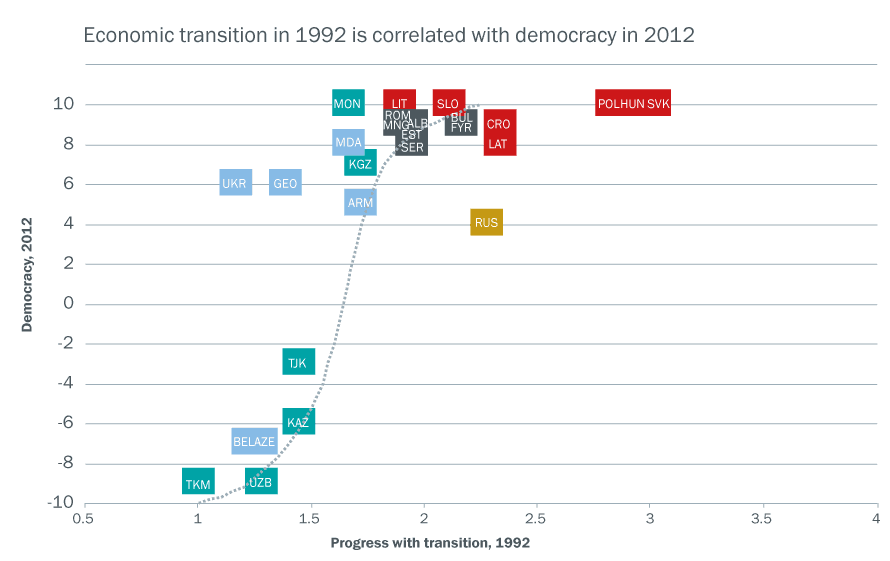Markets and democracy
Do market reforms promote democracy?
- Details
- Markets and democracy
Based on the foregoing analysis, one would expect market reform to support the process of democratisation indirectly by contributing to rising GDP per capita. The question is whether it has also directly helped democratisation in the transition region. Is there evidence that faster transition to a market economy, particularly in the early years of the transition process, may have helped or protected democratisation by preventing powerful elites from becoming entrenched?
Chapter 1 shows that there is a strong correlation between current levels of market‑oriented reforms, measured by the 2013 average of the EBRD’s country-level transition indicators,1 and current levels of democracy (see Chart 1.6). This correlation also works over time. Levels of democracy in 1992 help to predict transition indicators in 2012, and vice versa.
Chart 2.5 plots the average transition indicators in 1992 against the transition countries’ Polity2 scores in 2012. The chart suggests an S-shaped relationship between the two concepts, as was apparent in Chart 1.6.2
With some exceptions (such as Georgia and Ukraine), very low levels of transition in 1992 are generally associated with very low levels of democracy in 2012. The curve then becomes very steep, indicating that even slightly higher initial levels of transition tend to be predictors of much higher levels of democracy in 2012. After that, the curve levels off, reflecting the fact that even the most advanced economies in the transition region in 1992 cannot have democracy scores that exceed 10 in 2012.
This correlation need not necessarily imply a causal relationship. We could interpret the correlation in at least four ways.
- Cross-country differences in market reform in 1992 could reflect variation in democratisation at the time, which may still be felt in 2012.
- Differences in initial market reform could have been correlated with per capita income at the time, which could have an impact on democratisation.
- Initial market reform and democratisation could reflect the influence of geography or prospective EU membership (see Chapter 3).
- There could be a direct or indirect causal effect running from early transition to democratisation through faster growth and higher per capital income in the intervening period, or through the prevention of the formation of new elites opposed to democracy.
This analysis cannot confirm which of these interpretations is correct, but it suggests that neither the first two nor the “EU effect” can be the whole story. Column 7 of Table 2.2 shows a strong correlation between transition and future democratisation, even when controlling for past levels of democracy and per capita income. Columns 8 and 9 indicate that this is driven mostly by the fact that transition reduces the risk of democratic reversal. Importantly, column 10 shows that this effect persists even when the regression accounts for the impact of EU membership.
This shows that the effect of transition does not simply capture the fact that prospective EU members were more likely to pursue more vigorous reform and less likely to backslide in their progress towards democracy.
Of course, there might be factors other than the “EU effect” (such as an
historical predisposition towards both democracy and market economies in some countries),3 which could be picked up in the regression. However, the results in Table 2.2 are certainly consistent with the interpretation that early reformers were better able to defend their democratic regimes against backsliding if they also liberalised their economies ‒ perhaps because this prevented the rise of any groups of economic or political forces inside the country that had an interest in holding back democracy.
- The EBRD's six country-level transition indicators measure: (i) large-scale privatisation; (ii) small scale privatisation; (iii) governance and enterprise restructuring; (iv) price liberalisation; (v) trade and foreign exchange liberalisation; and (vi) competition policy (see Annex 2.1). [back]
- Note that the axes have been reversed relative to Chart 1.6 – that is to say, democracy appears on the vertical axis and transition on the horizontal axis. [back]
- See Chapter 3, Box 3.1. [back]














